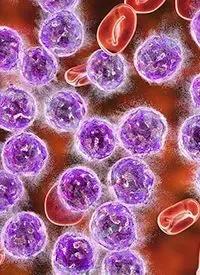Article
Epcoritamab Elicits Impressive Responses in Relapsed/Refractory LBCL
Author(s):
The first-in-class, subcutaneously administered T-cell–engaging bispecific antibody epcoritamab demonstrated deep and durable responses in patients with relapsed/refractory large B-cell lymphoma.
Large B-Cell Lymphoma

The first-in-class, subcutaneously administered T-cell–engaging bispecific antibody epcoritamab demonstrated deep and durable responses in patients with relapsed/refractory large B-cell lymphoma (LBCL), according to pivotal dose-expansion results from the LBCL cohort of the phase 2 EPCORE NHL-1 trial (NCT03625037) presented during the 2022 EHA Congress.1
At the January 31, 2022, data cutoff, patients with LBCL who were treated with epcoritamab (n = 157) achieved an overall response rate (ORR) of 63% (95% CI, 55%-71%), including a complete response (CR) rate of 39% (95% CI, 31%-47%). Three percent of patients had stable disease, and 24% experienced disease progression. Additionally, the median overall survival (OS) was not reached (NR), and the 6-month and 12-month OS rates were 70.6% (95% CI, 62.7%-77.2%) and 56.9% (95% CI, 47.3%-65.4%), respectively.
Notably, the median duration of response (DOR) for patients who experienced a CR was NR. The median time to CR was 2.7 months (range, 1.2-11.1). Overall, the median DOR was 12.0 months (range, 0+ to 15.5+) and the median time to response was 1.4 months (range, 1.0-8.4). The median follow-up time was 10.7 months (range, 0.3-17.9).
“Epcoritamab is a novel, subcutaneous bispecific antibody in development,” Catherine Thieblemont, MD, PhD, head of the hemato-oncology department at Hôpital Saint-Louis, in Paris, France, said in a presentation of the findings. “We know that relapsed and refractory LBCL is a difficult disease with a poor prognosis. The EPCORE NHL-1 dose-escalation cohort has been reported and published, with notable activity with clinically meaningful overall and CR rates as a single agent.”
The EPCORE NHL-1 trial enrolled patients with relapsed/refractory, CD20-positive mature B-cell neoplasms. Eligible patients had an ECOG performance status of 2 or less and underwent at least 2 prior lines of therapy, including at least 1 anti-CD20 monoclonal antibody. Prior treatment with CAR T-cell therapy was permitted.
Patients received subcutaneous epcoritamab at the recommended phase 2 dose of 48 mg weekly during cycles 1 through 3, biweekly during cycles 4 through 9, and 4 times per week during cycle 10 and beyond. Treatment continued until disease progression or unacceptable toxicity. Inpatient monitoring was required at the first full dose for 24 hours.
The LBCL cohort included patients with diffuse large B-cell lymphoma (DLBCL), high-grade B-cell lymphoma (HGBCL), primary mediastinal large B-cell lymphoma (PMBCL), and follicular lymphoma grade 3B (FL Gr3B).
The primary end point was ORR by independent review committee. Key secondary end points included DOR, time to response, OS, CR rate, progression-free survival (PFS), and safety/tolerability.
The median age of patients in the LBCL cohort was 64 years (range, 20-83). Half of the cohort had an ECOG performance status of 1 and 47% had a performance status of 0.
Most patients in the cohort had DLBCL (89%), including 70% with de novo DLBCL. Nine patients had HGBCL, 4 had PMBCL, and 5 had FL Gr3B.
The median number of prior lines of therapy was 3 (range, 2-11), and 71% of patients had at least 3 prior lines of treatment. Most patients had primary refractory disease (61%) and most patients were refractory to their last systemic therapy (83%). Prior CAR T-cell therapy was reported in 39% of patients, and 75% progressed within 6 months of CAR T-cell therapy.
At the data cutoff date, 32% of patients were continuing with treatment and 68% had discontinued treatment. Reasons for treatment discontinuation included progressive disease (53%), adverse effects (AEs; 7%), allogenic stem cell transplant (4%), withdrawal by patient (3%), and other (1%).
Further data from the trial showed that responses were consistent across key subgroups; patients experienced an ORR of at least 46% regardless of age, disease histology, CAR T-cell therapy exposure, or number of prior lines of treatment. Notably, patients who were CAR T-cell therapy naïve (n = 96) achieved an ORR of 69% with a CR rate of 27%. Patients who were at least 75 years old (n = 29) and those with transformed DLBCL (n = 40) also had particularly high response rates, with ORRs of 72% and 68%, respectively.
The median PFS for complete responders was NR, and 89% of complete responders remained in CR at 9 months. The overall median PFS was 4.4 months (95% CI, 3.0-7.9) and the overall PFS rate at 6 months was 43.9% (95% CI, 35.7%-51.7%).
Additionally, an exploratory circulating tumor DNA analysis showed that minimal residual disease (MRD)-negative responses were durable and correlated with PFS. Among 107 evaluable patients, the MRD-negative rate was 45.8% (95% CI, 36.1%-55.7%)
In terms of safety, most AEs were low-grade and occurred during the first 3 treatment cycles. Common AEs of any grade included cytokine release syndrome (CRS; 49.6%), neutropenia (28%), pyrexia (23.5%), and fatigue (22.9%). Ten patients experienced immune effector cell-associated neurotoxicity syndrome (ICANS) of any grade; 9 of these were grade 1 or 2 and resolved and 1 patient experienced grade 5 ICANS.
CRS events were primarily low grade and predictable; 31.8% of patients who experienced CRS had a grade 1 event, 15.3% had grade 2, and 2.5% had grade 3. The median time to onset of CRS from the first full dose was 20 hours, and 98.7% of patients had their CRS resolved. The median time to resolution from the first full dose was 48 hours, and CRS led to treatment discontinuation in only 1 patient.
“Epcoritamab is well tolerated and drives deep and durable responses in this cohort of patients with challenging-to-treat relapsed/refractory LBCL,” Thieblemont concluded.
Reference
- Thieblemont C, Phillips T, Ghesquieres H, et al. Primary results of subcutaneous epcoritamab dose expansion in patients with relapsed or refractory large B-cell lymphoma: a phase 2 study. Presented at: 2022 EHA Congress; June 9-12, 2022; Vienna, Austria. Abstract LB2364









